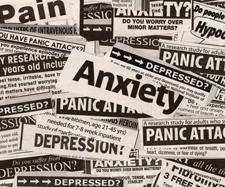Defining common mental health terms
From news stories, to the latest celebrity gossip, most of us have at least heard of terms like mood disorders, anxiety disorders and addictions. But what do these really mean and what illnesses fall into each category? Read on to find out more about some of the most common terms being used today in mental health.
Defining mental health
According to Health Canada, mental health is “the capacity to feel, think and act in ways that enhance one’s ability to enjoy life and deal with challenges.” A person with good mental health is typically able to handle life’s ups and downs effectively: fully enjoying pleasurable moments, managing stressful times positively, actively exploring interests and goals and connecting with other people in a meaningful way.
A person with mental health challenges, on the other hand, usually has trouble responding appropriately to these kinds of situations, resulting in excessive stress or worrying, anger or frustration, and self-esteem issues amongst other symptoms. The realities of day-to-day living and trying life events (e.g., a layoff, death or break-up), mean that most of us, on occasion, face mental health challenges for short periods of time.
A mental illness or disorder is usually diagnosed when mental health challenges go unresolved over time, or worsen to the point where they significantly interfere with day-to-day functions and interactions—e.g., at work, school or in relationships. The source of the illness/disorder can be either psychologically and/or biologically-based and the sufferer usually benefits from professional treatment. Some disorders or mental illnesses are more cyclical—meaning that a person can have episodes of illness followed by long periods of wellness—while others can drag on for long periods of time.
Common disorders
Over the years, hundreds of different mental health-related disorders have been identified. Some of the most common disorder groups are:
Mood disorders which include depression and bi-polar disorder. Unlike normal sadness, someone suffering from depression will typically stay in a depressed mood—which not only includes extreme sadness, but also a disinterest in normally pleasurable activities—for two or more weeks. People with depression may also have other symptoms like disturbed sleep, low energy, trouble focusing thoughts and making decisions and weight fluctuations.
People with bipolar disorder (until recently, commonly referred to as manic-depression) usually suffer from extreme mood changes that have nothing to do with life events. Sufferers may swing from a depressed state to extended periods (usually lasting more than a week) of its polar opposite: mania. Common signs of mania include: feelings of euphoria, a noticeable increase in energy, a reduced need for sleep or insomnia, irritability and risky behaviours.
Anxiety disorders often go hand-in-hand with depression and are considered the most common group of mental disorders facing North Americans. Anxiety disorders are typically marked by uncontrolled worry that can interfere with sleep, cause physical tension and emotional irritation and create a feeling of being "wound up" or "on edge." Anxiety disorders include: obsessive-compulsive disorder (OCD), post-traumatic stress disorder (PTSD), panic disorder, generalized anxiety disorder (GAD) and specific phobias such as fear of heights, animals, flying, etc.
Eating disorders. As the name suggests, eating disorders involve an unhealthy or obsessive relationship with food, eating and body image that can have a negative impact on a person’s relationships, life and health. The most well-known eating disorders are anorexia nervosa and bulimia nervosa.
People grappling with anorexia nervosa usually have an extreme fear of gaining weight and often think of themselves as “fat” even if they are severely underweight, usually depriving themselves of food because of this.
While those suffering from bulimia nervosa may face similar body image issues as people with anorexia, people diagnosed with bulimia nervosa typically have a normal body weight. Bulimia nervosa involves binge eating of excessive amounts of food, followed by a “purge.” Purging can include vomiting, the abuse of diuretics or laxatives and excessive exercise.
Substance use disorders. These disorders are usually talked about as substance abuse and addiction. Substance abuse refers to a behaviour that happens when a person uses and continues to use a chemical substance (e.g., illicit drugs, tobacco, alcohol, prescription medications), while fully understanding the negative impact the use of the substance can have on health, relationships, work, etc.
Addiction, suggests the person is unable to control substance use—whether because of physical or psychological dependence—and can cause serious physical and/or mental distress if they quit taking the substance or cut back. Recently addiction is also being used to discuss extreme compulsive behaviour issues such as gambling, shopping and sex.
Mental health issues and the terms used to describe them aren’t always straightforward and clear cut: signs and symptoms can vary from person to person and people can often grapple with multiple disorders at the same time. If any of the descriptions above seem familiar in describing you or a loved one, it’s always best to seek support—through your physician or another mental health professional—as soon as possible.
